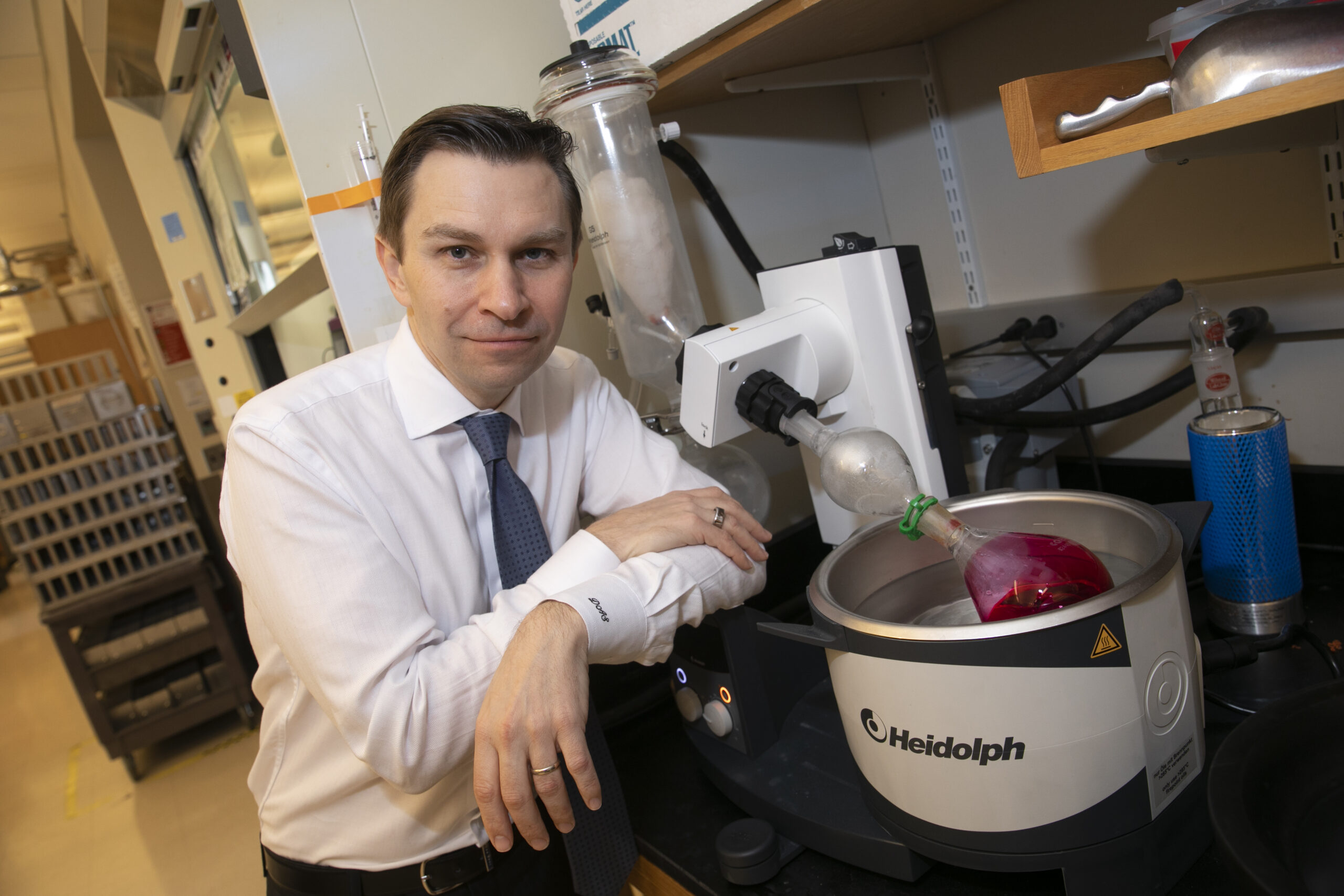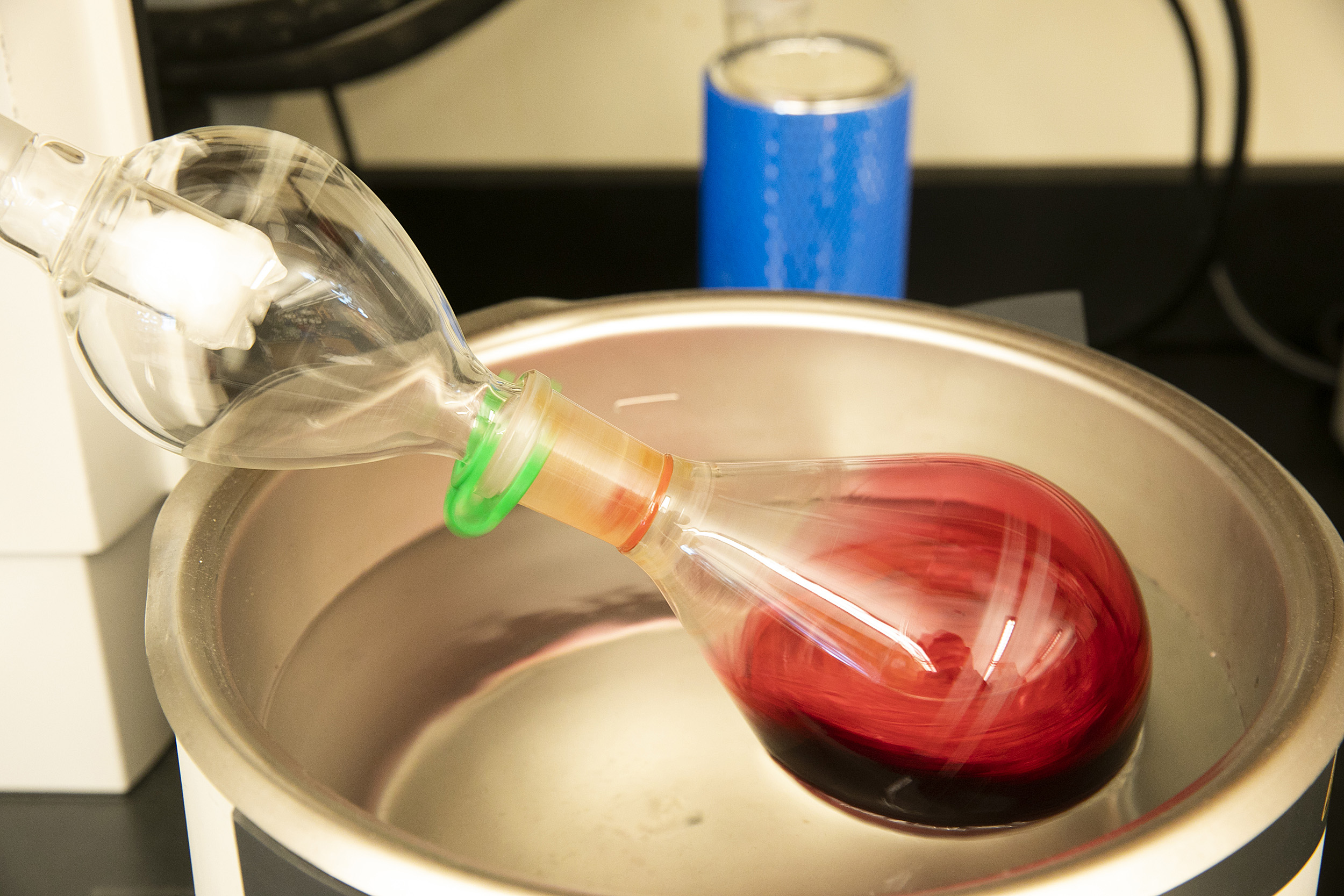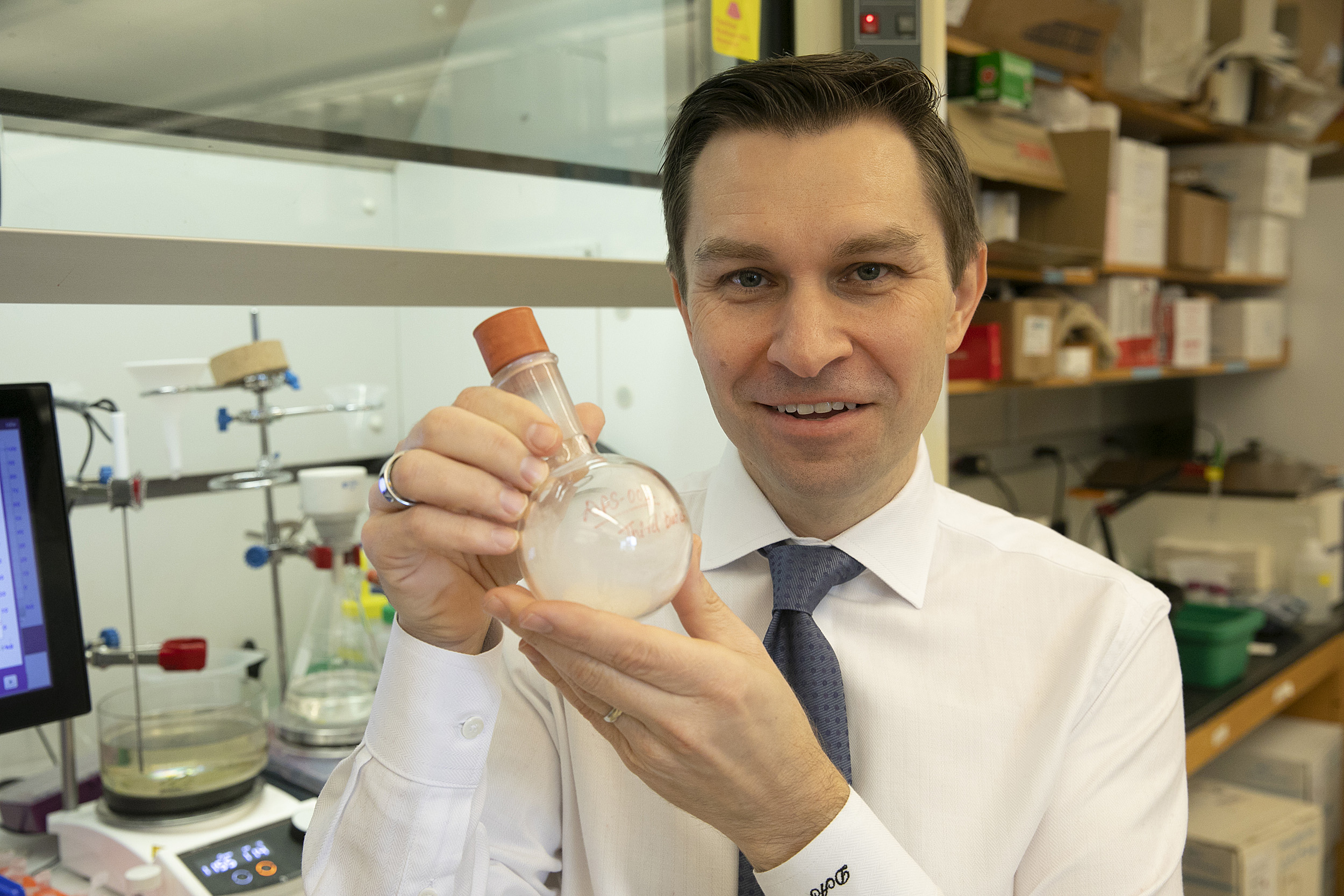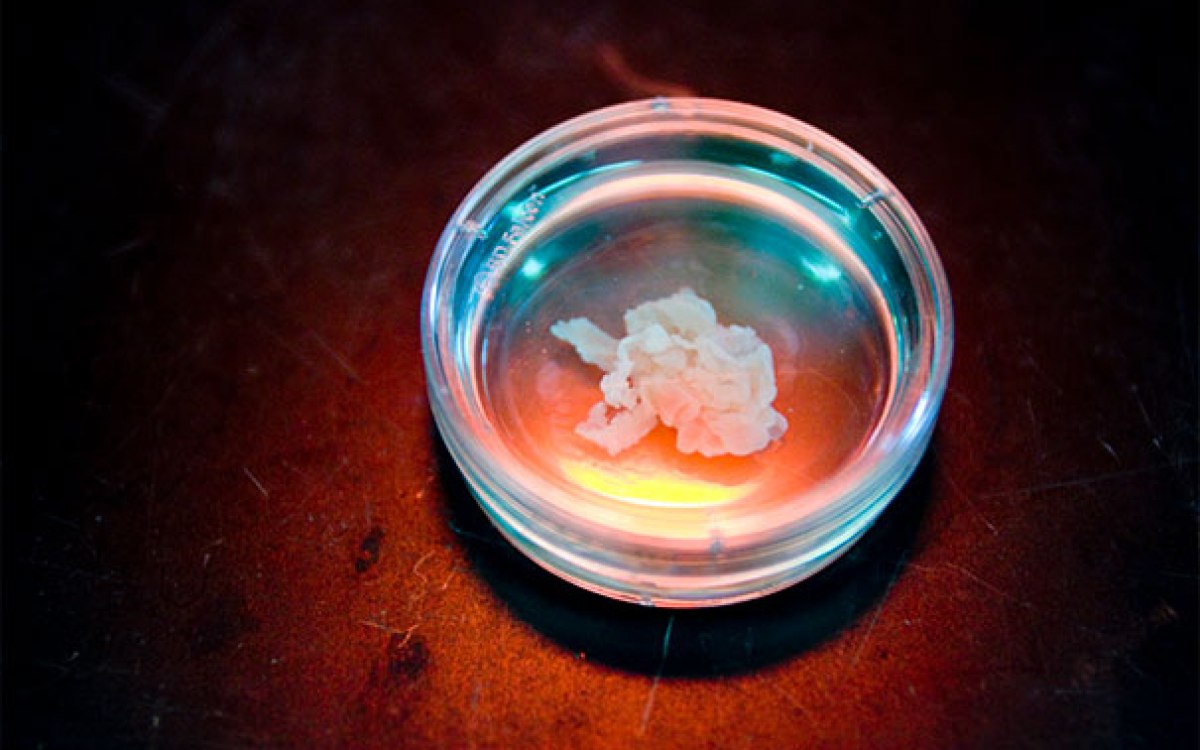
David Sinclair is among a group of researchers collaborating on a new nonprofit academy to promote aging research and drug discovery.
Jon Chase/Harvard Staff Photographer
Longevity and anti-aging research: ‘Prime time for an impact on the globe’
HMS’s Sinclair discusses new nonprofit academy for work on extending the human lifespan
Research into longevity and healthy aging has progressed rapidly in recent years, but intense interest from the public, corporations, and the media has created an environment in which unfounded claims can be hard to separate from scientific facts.
In February, a group of 16 researchers from Harvard, MIT, and other institutions around the U.S. and Europe launched the nonprofit Academy for Health and Lifespan Research to promote future work, ease collaborations between scientists, and ensure that governments and corporations are making decisions based on the latest facts instead of rumor, speculation, or hype.
The Boston-based organization will form a nexus for work on extending the human health span, fighting the myriad diseases associated with aging, and fostering the work of junior researchers. Harvard Medical School Genetics Professor David Sinclair, one of the new academy’s founding members and director of the Paul F. Glenn Center for the Biology of Aging at HMS, spoke to the Gazette about the status of aging research and the mission of the academy.
Q&A
David Sinclair
GAZETTE: Tell me about the academy. Is it intended to be mainly an advocacy organization?
SINCLAIR: The academy has been formed because our field of aging and longevity research has reached a point of maturity where the leaders in the field believe that we can have — or will have — a big impact on the planet. That impact will be in medicine, in health span, and in its knock-on effect on [everything from] human productivity to Social Security.
We wanted to come together to speak with one voice, to be able to help corporations and governments understand what things they should be thinking about now and give realistic projections of what life is going to be like 10, 20, 50 years from now. Because it’s not a question of if there’s going to be an impact, it’s really a question of what kind of a future we want to build when this happens.
GAZETTE: What kind of impact are we talking about? When you think about 10, 20, 50 years in the future, how do you see aging being transformed in the U.S. and around the world?
SINCLAIR: The 16 researchers in the academy have all been working on this for most, if not all, of our careers. So that spans — for many of us — over 25 years. When we started, research on aging at the molecular level was the backwater of biology, but in the last 25 years, aging has moved to the forefront of science. It’s actually rare to open a leading scientific journal and not see a new breakthrough in our understanding of the aging process.
Recently, we’ve moved from being able to extend health and lifespan of simple organisms like yeast and worms and flies to being able to do this quite easily in animals, in mice and monkeys. With that knowledge — how to keep the body younger and not develop diseases of aging — we think it’s now prime time for having an impact on the globe.
By impact, I mean that instead of tackling one disease at a time, which is the way 20th-century medicine and pharmaceutical development was practiced, we believe we can [develop] medicines that will treat aging at its source and thereby have a much greater impact on health and lifespan than drugs that target a single disease.
Heart disease medicine may keep your heart healthy for an extra five or 10 years, but does nothing for your brain. So, we’re ending up with a population of people who live longer but not better and who need a lot of help, if they’re not completely [in the grip of] dementia. We don’t think that’s necessarily the only or the best approach.
“We’re generally in denial that, for most of the diseases that we get these days, the root cause is aging. I don’t know 10-year-olds that get Alzheimer’s disease or heart disease.”
David Sinclair
Now, we have the knowledge. We’re developing the technologies to not just delay these diseases of aging but actually reverse aspects of them. Imagine you have a treatment for heart disease, but as a side effect you’d also be protected against Alzheimer’s, cancer, and frailty. You’d live a longer and healthier life.
The reason we can extend the lifespan of animals is not because we can just make them live longer, but we keep them healthy. The animals don’t get heart disease, cancer, Alzheimer’s, until sometimes 20 percent later in their life. And so that’s 20 percent longer youth, not just 20 percent longer life.
GAZETTE: Are there regulatory hurdles? When we’ve spoken in the past, you’ve mentioned that the FDA considers aging a natural process and therefore won’t approve drugs to treat it. Are we at a point where that is becoming a hurdle in getting advances out to the people who need them?
SINCLAIR: Opinions are changing rapidly about whether aging should be a condition that a doctor can prescribe a medicine for. That’s essentially what a disease is. It’s something that a doctor can read the label that this medicine is for aging or age-related conditions. We’re not at that point yet.
We currently live in a world where aging is so common that it’s considered by most of the world, including the medical community, as something that’s natural and inevitable. And if something’s considered inevitable, typically you don’t focus on it in the same way as something you can treat. Cancer was a natural part of life at one time, in the same way that aging is today. A hundred years ago, doctors didn’t focus on treating cancer as much as we do now, because then you couldn’t do much, if anything, about it. As soon as you show you can modify the disease process, like we learned in the 1970s with the discovery of oncogenes that cause cancer — and increasingly so today — then there’s renewed hope, and views about the condition shift.
There are now dozens of companies working on therapies that could potentially extend overall human health and lifespan, but none of them are working specifically toward an approval for aging because the FDA wouldn’t even know where to start. But that may be changing quickly. I’ve been part of a group that talked with the FDA, and they are willing and also quite enthusiastic about considering a change that defines aging as a disease. They would like us, first, to show that it’s possible to change the rate of aging, which in my view is backward, but that’s what they want.
In Australia, the government is 100 percent behind this, at the FDA level and in the Ministry for Health. I’m hopeful that one country in the world — it may be Australia, it may be the U.S., it may be an Asian country — will change its definition of aging. Once one country changes its definition, then it will be a domino effect and the others will follow.
One of the biggest changes that happened last year was the World Health Organization, in their international disease codebook, declared aging a condition that is treatable. So now doctors and countries can report back to the World Health Organization how many people in their country are suffering from this condition known as “old age.”
We’re generally in denial that, for most of the diseases that we get these days, the root cause is aging. I don’t know 10-year-olds that get Alzheimer’s disease or heart disease. It’s aging that increases the risk 1,000-fold for cancer, while if you smoke, it goes up fivefold. Which is more important to be focused on?
GAZETTE: What excites you most about the state of anti-aging and longevity research?
SINCLAIR: Well, I hate to pick favorite children. Someone will always be upset. I have my hands in a few pies, but the most recent one that I’m excited about is cellular reprogramming.
GAZETTE: And how does that occur?
SINCLAIR: We introduce a combination of genes into the animal, or the cell, and we see that the tissue is rejuvenated as though it was young again. So it can heal, it can start new growth, like it was young. And if we can figure out how to deliver that to patients in a safe way, then it’s quite possible that aging is a reversible disease.
GAZETTE: What genes are we changing?
SINCLAIR: We’re using a combination of Yamanaka factors [used to reprogram differentiated adult cells into induced pluripotent stem cells] that are used to make stem cells currently in a dish, but what we’re finding is that you can introduce them into the animal as well. They tolerate it well and tissues rejuvenate.
I haven’t published it yet, so I can’t say too much, but we’re writing up the paper now that shows that parts of the mouse’s body that we thought would not ever improve are able to be regenerated. So we’re licensing that technology and hoping that it will be tested in the clinic in the next two years.


David Sinclair shows off an evaporator device used in the lab.
Jon Chase/Harvard Staff Photographer
GAZETTE: How likely do you think it will be that the broad public accepts a solution that involves changing themselves at a cellular level? Is that a high hurdle?
SINCLAIR: If you’re going blind, I think you’d be quite enthusiastic about it.
Clearly we need to make sure it’s safe, too.
You asked me what I’m most excited about and it’s that one that has the biggest potential. But the one that’s closest to reality are the NAD boosters that we’ve had in clinical trials for over a year now over at the Brigham and Women’s Hospital.
GAZETTE: There have been some trials completed on those already, right?
SINCLAIR: Yes, we’ve done two trials, but they’ve been safety trials.
We’re just getting approval now to test it in older people. Ultimately, we’re planning on treating particular inherited diseases. I can’t say which ones without permission, but these drugs will typically be for diseases that are rare or less common.
In the future, if a molecule or a drug makes it onto the market for one particular disease, then doctors can test it on their particular disease of expertise. And, if it works there — just like the statin drugs — expand it from a small group of families with high cholesterol [in the case of statins] to the world. But that would only happen if the drug was really safe.
GAZETTE: Is it most likely that something like a NAD booster will be taken daily by many people, in the way that statins are today, or, given the greater promise of the engineering approach, something like that being used widely? Or is there a third that you think might actually surpass those two?
SINCLAIR: I think that this drug has the potential to be used widely, like a statin.
If you reach age 45 and your blood glucose has crept up, you’re losing muscle strength and volume, and your doctor may say, “Hey, I can see that you’re starting to age.” They could then actually measure your biological age now pretty accurately with a blood test. The doctor might then say, “There’s this drug, it seems pretty safe, there’s no downside that we can tell and it protects you from all age-related diseases. Start taking it now before it’s too late.”
That’s the trick. You get the biggest bang for the buck if you treat before you get sick. That’s true for most diseases and it’s certainly true for the mouse populations we study here in the lab.
But this cellular reprogramming is exciting because it seems to work even once you’ve lost function of tissues.
GAZETTE: Kind of turning back time?
SINCLAIR: Right. It’s going to end up being a combination of treatments that are used, I think.
That’s why I’m trying to help other entrepreneurs with their own inventions, so that we can address different aspects of aging and ultimately keep people healthier for much longer than we currently can.
GAZETTE: To go back to our initial point, how do you see the Academy for Health and Lifespan Research doing its work? Will there be staff here in Boston? Will investigators like yourself spend a particular amount of time there?
SINCLAIR: We have our own secure network that we communicate and collaborate on, so first of all, it’s been a great step forward just linking us together.
Also, it’ll be headquartered here in Boston by David Setboun, the president. He’s hiring staff now. And those staff will be similar to other nonprofit organizations. There will be a philanthropic side, raising money — and also distributing the money that’s being raised. The money will be used to bring scientists together. There’s an annual meeting.
We think we’ll be able to sponsor young scientists and help research that way; we professors want to be able to replace ourselves with even better talent. Also, we’re planning on putting out publications to separate what’s real from what’s not real. The public finds it very difficult to distinguish science from fake science right now.
GAZETTE: Part of that may be intentional.
SINCLAIR: I’ve been successful in getting my name off a lot of websites, but the research, Harvard’s name, and my face are still used by companies to insinuate that I endorse their product, when I would never do that. My lab and I don’t receive any money from the sale of supplements.
That’s a problem we want to solve. By uniting, we can have a seal of approval, where we can say this is what’s real, this is what isn’t, this is what we believe, as scientists, and this is not what we believe. And we have a website with this information, that’s going to be populated with white papers, and I suspect we’ll also be putting out other publications.
As the field grows, with interest from the lay public and investors and the media, we want to make sure the conversation stays evidence-based.








